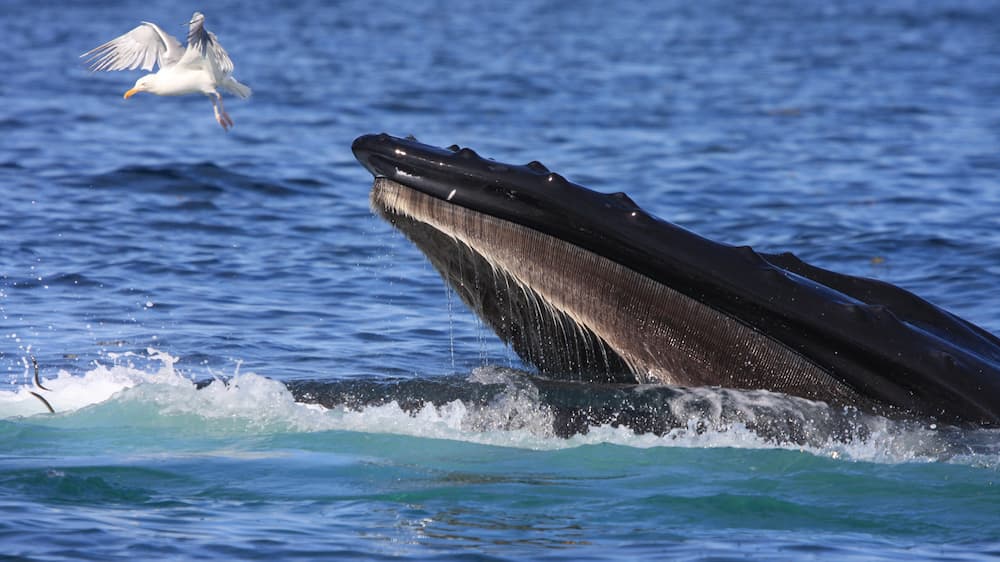
A whale watch is not an amusement park ride and sightings may vary widely. Each trip is a unique experience.
Whales are classified into two different types – baleen whales and toothed whales. Baleen whales have plates of baleen (made of keratin like our hair or nails) hanging from their upper jaws with which they filter their food; and toothed whales have conical or spade-shaped teeth in their upper and lower jaws. Most sightings are of humpbacks, fin whales, and minke whales (baleen whales), but dolphins and porpoises (toothed whales) are also regularly spotted.
Fin Whale
Photo: NOAA (NOAA Fisheries Permit #775-1875)The largest of the baleen whales found in these waters (and second only to the blue whale). Grows up to 75 feet long. This whale is a quick swimmer, rarely breaches, has a chevron marking on its back, and does not show its tail when it dives. It is asymmetrically colored with a white jaw and baleen on the right side and dark on the left.
Status: Endangered; Protected under MMPA.
Humpback Whale
Photo: Elliott Hazen (NOAA Fisheries Permit #14245)The acrobat among the whales, often displaying behaviors that incorporate tail slaps, flipper slaps, full and partial breaches, and spyhops. Reaches about 45 feet in length. Humpbacks each have a unique pattern on the underside of their tails. The sanctuary has an active humpback whale behavior research program.
Status: Protected under MMPA.
North Atlantic Right Whale
Photo: Peter FloodThe most critically endangered of the great whales. This whale is identified by its V-shaped blow, lack of dorsal fin, paddle-like flippers, white callosities on its head, black body, and the smooth trailing edge of its tail. Reaches about 50 feet in length and weighs as much as 70 tons. Laws prohibit close approaches so whale watch vessels avoid them; if boating, please stay at least 500 yards away from the animal. Here are ten things you should know about right whales.
Status: Endangered; Protected under MMPA.
Sei Whale
Photo: NOAA/NMFSThis whale is sometimes seen in the sanctuary. It can strain plankton from the water but also feeds on schools of fish. The sei whale resembles a fin whale in shape but with a darker color, few markings, shorter size (up to about 40-60 feet), and a more pointed snout. Like the fins, they do not arch their backs or show their flukes when diving.
Status: Endangered; Protected under MMPA.
Minke Whale
Photo: Anne Smrcina/NOAAThe smallest of the great whales, the minke tops out at about 35 feet and 10 tons. Its scientific name suggests its appearance as a sharp-nosed winged whale, distinguished by the white patches or “bandages” on each flipper. They rarely lift their tails out of the water when they dive and their blows are bushy but not very visible to whale watchers.
Status: Protected under MMPA.
Atlantic White-Sided Dolphin
Photo: Elliott HazenThe dolphin most often seen during whale watches, the Atlantic white-sided is named for its white and yellowish stripe along its sides. Often found in pods of several dozen to several hundred. They can reach lengths of nine feet and weigh up to 500 pounds.
Status: Protected under MMPA.
Common Dolphin
Photo: Sean Whelan/WHOIAlso known as short-beaked common dolphin, this species can be identified by its distinctive color pattern, which is often referred to as an ‘hourglass.’ A dark gray cape extends along the back from the head to just below the dorsal fin where a "V" is visible on either side of the body, creating an hourglass. This is one of the most abundant and familiar dolphins in the world.
Status: Protected under MMPA.
Harbor Porpoise
Photo: NOAAThis is the smallest of the toothed cetaceans in the sanctuary, growing to about five feet in length. The harbor porpoise is a shy animal, most often seen alone or in groups of two or three. It has a small, robust body with a short, blunt beak, a medium-sized triangular dorsal fin, a dark gray back, and white belly and throat. They are usually seen closer to shore.
Status: Protected under MMPA.
Gray Seal
Photo: Anne Smrcina/NOAA.This larger seal has a blockier head that is often compared to a horse.
Harbor Seal
Photo: NOAAThe smaller of the two seal species. Its head is more dog-like in shape.
Basking Shark
Photo: Anne SmrcinaThe largest shark in the sanctuary. It has minuscule teeth and eats zooplankton, which it filters through its gill rakers.
Blue Shark
Photo: Greg Skomal/MassDMFLarge but not as big as white sharks; scavenges on whale carcasses and preys on smaller fish.
White Shark
Photo: Shark-Greg SkomalThis shark preys on seals (usually gray seals) but can also scavenge on the bodies of dead whales.
Ocean Sunfish (aka Mola mola)
Photo: Greg Skomal/MassDMFThis large disk-like fish often floats on its side. When upright, its large dorsal fin is sometimes mistaken for a shark.
Bluefin Tuna
Photo: Greg Skomal/MassDMFSchools of young football-sized tuna can leap out of the water as they chase prey fish.
Sand Lance
Photo: NOAA (NOAA Fisheries Permit #775-1875)Many small splashes may indicate a school at the surface. You may see sand lance leaping from a feeding whale’s mouth to safety.
Krill
Photo: Ari Friedlaender (NOAA Fisheries Permit #14245)Small specks of red may dot the surface when a whale lunge feeds on a zooplankton patch.
Kemp’s Ridley Sea Turtle
Photo: NOAA/NMFSThese turtles may visit our waters during the summer months; large numbers have washed up cold-stunned on Cape Cod beaches in late fall.
Loggerhead Sea Turtle
Photo: Anne Smrcina/NOAAThese larger turtles have occasionally been seen; a few wash up cold-stunned in early winter.
Leatherback Turtle
Photo: Peter FloodThe largest turtle with a black, leathery skin (no shell). This highly migratory species eats gelatinous zooplankton.
Lion’s Mane Jelly
Photo: Keith EllenbogenThe large bell and long tentacles are distinctive for this gelatinous creature, which is food for sea turtles and ocean sunfish.